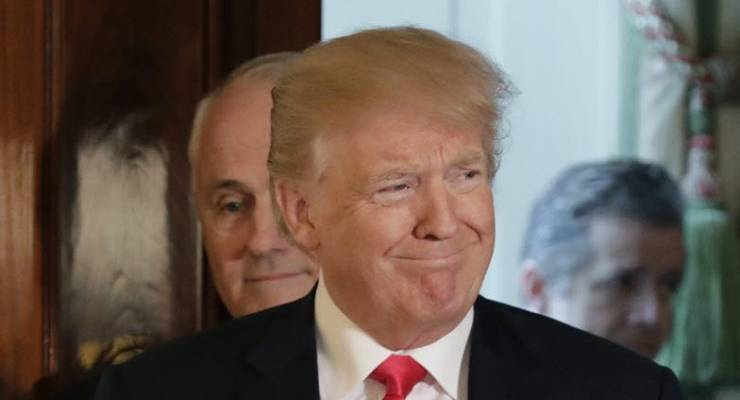
Evidence is now emerging of just how extraordinarily wasteful Donald Trump’s trillion-dollar corporate tax cut has been as the results — or lack thereof — filter into the real US economy.
It’s now well-established that the bulk of the tax cuts have gone into record-breaking share buybacks and increased dividends by US companies, with hundreds of billions of dollars flowing or set to flow back to investors. But not a lot of the rest is flowing into extra investment — the raison d’etre of company tax cuts. New investment data shows US equipment investment fell in the first quarter of the year compared to the final quarter of 2017. How about wages, which are supposed to increase due to company tax cuts (at least according to Mathias Cormann)? In June, monthly wage growth in the US fell to 0.2% from 0.3% in March, lower than expected and leaving wage growth at 2.7% for the 2017-18 year. Inflation in the US was 2.8% for the year to May, suggesting US workers are actually going backwards after inflation.
US unemployment is at 4% (up a tad) — far below our own level of 5.5%. Like the Kiwis, the Americans can’t get wages to grow even with full employment — or even with tax cuts that have massively inflated the US deficit at a time of peak employment.
The fact that Trump and his GOP cronies have pushed the US budget deficit toward $1 trillion a year (remember when the Republicans were the party of fiscal restraint?) at a time of such strong employment also has implications for the stimulatory effect of such largesse. New research from the San Francisco Federal Reserve shows that fiscal stimulus is significantly weaker at times of expansion than during recessions, and that the Republican tax cuts will not meet what the paper terms the “overly optimistic” expectations of boosters. Instead of the boost to US GDP growth this year of about 1.3 percentage points estimated by the Congressional Budget Office and other forecasters, they write, “the true boost is more likely to be less than 1 percentage point,” with some studies pointing to as little as zero.
It gets worse. All those share buybacks are leaving American investors unimpressed: according to the Wall Street Journal, 57% of the more than 350 companies in the S&P 500 that announced share buybacks so far this year are trailing the S&P500 index’s 2018 rise of 3.2%, while the S&P 500 buyback index (yes, there’s actually an index to measure the impact of share buybacks, measuring the performance of the 100 biggest stock repurchasers) has risen just 1.9% this year. But since the S&P 500 peaked on January 26 this year, the buyback index’s underperformance has widened: since January 26, the buyback index is down 6.2%, while the S&P 500 is down 3.1%. It seems much of the boost to share prices happened in late 2017 ahead of the start of the tax law changes in late December — another example of the old adage of buy on the rumour and sell on the fact.
It’s now clear that the Trump company tax cuts haven’t delivered any of the benefits claimed by spruikers — both in the US, and here, at the Business Council, in the government or at the Financial Review. But could it be that Trump and the GOP are so incompetent that they’re going to blow nearly $2 trillion on stimulating an already heated economy and manage not merely not to increase investment or wages, but not increase growth at all, and leave share prices underperforming? That would be some achievement.









Does anyone know if the Business Council spokesperson, who at a recent Senate hearing had to take on notice the question of whether wages in any country had ever risen due to a reduction in corporate tax, has actually found somewhere, or are we still waiting ?
The sound of crickets
Oh, you mean trickle down really is just a myth? I’d never have guessed.
And yes all you hard working Australian voting sheeples, the LNP charlatans led by Malfeasance Turnbull, aided and abetted by Scoundrel Morrison are about to inflict the same on the Australian economy. The downside being, that a few years down the track when our debt (currently defined as good, will be reclassified as bad debt) becomes a problem once again, there will be cuts to hospitals, schools, pensions, social programs and other community well being matters.
Meanwhile in America Donald Trump certainly gained and done alright from those tax cuts. As for hard working Americans sweet FA for them.
“More American manufacturing workers are employed today than at any time in the last ten years as President Trump’s ‘America First’ economy seeks to protect U.S. industry and jobs with tariffs, less immigration, and tax relief.” – Breitbart, July 10, 2018. “Average hourly earnings increased 2.7 percent from a year earlier, more than projected, while the jobless rate fell to 3.8 percent from 3.9 percent to match April 2000 as the lowest since 1969.” – Bloomberg, June 1, 2018. So, as far as I can tell, more people have jobs after the tax cuts, and wages are rising, not falling.
LOL, you’re full of it buddy.
Wages growth have, at best, stagnated since Trump’s tax cuts were passed
https://tradingeconomics.com/united-states/wage-growth
Unemployment rates have been largely unchanged at around 4%, & actually rose in June.
https://tradingeconomics.com/united-states/unemployment-rate
So, if you’re going to defend Trump……at least bring proper facts to the table.
Also, my apologies for not having a source, but just read this week that employers, whose businesses are growing due to tax cuts and other economics, are now having to raise wages to attract people to work for them. Sounds to me as though tax cuts are working.